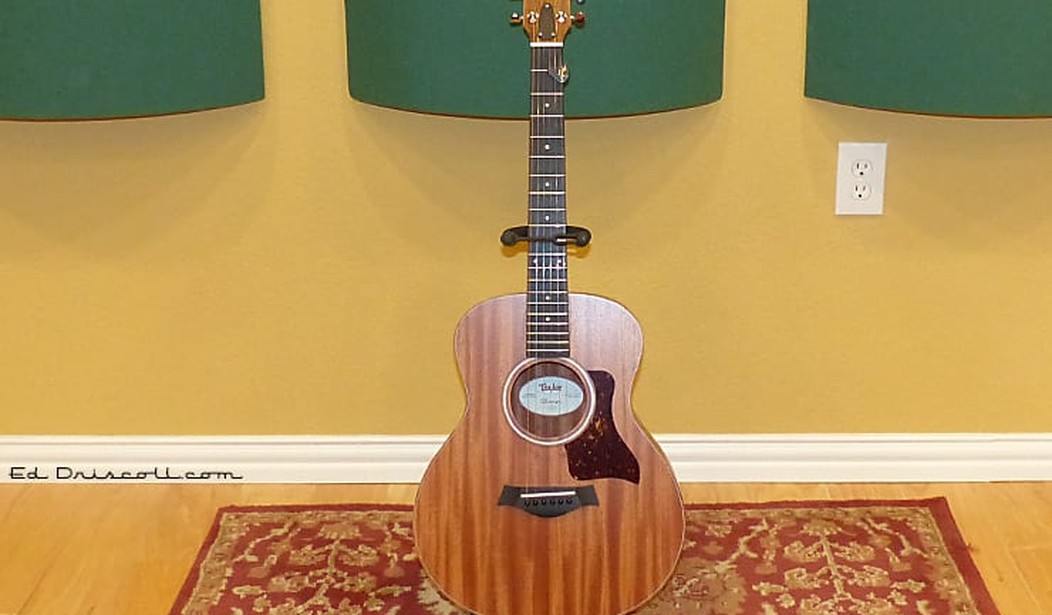Why your guitar should be high-strung, not its player. Plus a review of Taylor’s GS Mini acoustic guitar, professionally setup for Nashville tuning.
If you’ve read articles about the history of the Rolling Stones, Pink Floyd, or Tom Petty, you may have come across references to their use of a “Nashville-tuned” or “high-strung” guitar on such FM classic rock staples as “Wild Horses,” “Comfortably Numb” and “Free-Falling.” So what is a Nashville-tuned guitar, and if you’re a songwriter and/or home recording enthusiast, what can it do for you?
Unlike most alternate tunings for guitars, which involve taking the instrument’s usual six strings and raising and lowering a few of them to tune to a chord, Nashville tuning is typically (but not always!) played in standard tuning, and using the standard high E and B strings, but as Ed Mitchell of guitar string manufacturer D’Addario & Co. writes, “The remaining strings (G, D, A and low E) are tuned an octave higher than a regular guitar – just like they would be on a 12-string guitar.” Alternate tunings are a mixed blessing — having to learn new chord shapes can open new doors for songwriting, but there’s always that initial confusing feeling of “where am I on the fretboard?” In contrast, Nashville tuning generates all sorts of interesting tonal sounds due to its unique stringing pattern, but they all use familiar standard tuning chord shapes.
Nashville tuning is a device that country and western guitarists have been doing since the early days of stereo recording. When a song with a Nashville-strung guitar is mixed, typically a conventionally-strung guitar is panned far right or left, and the Nashville-tuned guitar is placed on the opposite side of the mix. The result is the equivalent of a giant stereo 12-string guitar. But the two guitars can be panned closer together, or right on top of each other, for what some have called “a poor man’s 12-string guitar” (but one in which each guitar can be treated with their own individual effects or EQ to either pop out or sit back in the mix as necessary.
Wake Up, Little Tuning
Nashville tuning was, according to multiple sources, including this 2017 post at Ultimate Guitar.com, invented by Ray Edenton, one of the Everly Brothers’ backup guitarists, in the early 1960s:
In the 1960s, it was usual at Nashville recording sessions to have two acoustic guitarists. One of the guitars often played with a capo for complex chord voicings. Then during an Everly Brothers session, Ray Edenton replaced a regular wound G string on his acoustic with a plain string tuned an octave higher. This tuning got the name “High Third” and became quite widespread because it added the sparkle to a standard rhythm guitar without dropping any of the low notes that a capo would take away.
Later, Edenton went further and strung up a standard acoustic guitar with the high strings from a 12-string set, substituting all wound strings with strings an octave higher. This tuning became identified as “Nashville Tuning,” also often called “High Strung,” though technically, in pure “High Strung” tuning, the G string isn’t tuned up an octave.
The tuning began to cross over to the rock world in the late 1960s, thanks to Keith Richards, according to D’Addario’s Ed Mitchell:
Back in the 60s, Keith Richards of The Rolling Stones was in San Antonio, Texas. While he was in town Richards learned the secret of Nashville tuning from the guitarist in country legend George Jones’ band. A few years later, Keith used the tuning on one of The Rolling Stone’s greatest songs, “Jumpin’ Jack Flash.” Listen to the song’s intro and you’ll hear two acoustic guitars being strummed by Mr. Richards – one tuned to open D with a capo and another in Nashville tuning. It’s clear that Keith liked to experiment, and if you like to get creative with your guitar sounds then Nashville tuning is perfect for you.
Richards and then-Stones co-guitarist Mick Taylor would combine a Nashville-strung guitar with a conventional 12-string on their classic 1971 song “Wild Horses.”
David Gilmour would use his own variation on what he called a “high-strung” guitar on what would become an FM radio perennial, “Comfortably Numb,” recorded in 1979, as he explains to music business veteran Paul Rappaport in 2012:
From Digital Trickery to Analog Reality
As for myself, I started using Nashville tuning when I acquired my Roland VG-99 guitar modeling system in 2007 (which requires a guitar equipped with a Roland-compatible hexaphonic pickup), and a model of an acoustic guitar with this tuning was one of the original factory presets. Besides the aforementioned doubling of a conventional guitar when they’re both strumming away on the same chord changes, I found that it’s also great for adding unique tonal colors via strums, accents and arpeggios in strategic locations in songs. Being an octave up helps to make these parts really contrast with and cut-through guitar parts in standard tuning. You can hear it employed in that fashion in several spots on Fleetwood Mac’s boxcar-selling 1977 Rumours album by Lindsey Buckingham.
In 2016, I came across a video by the online music merchant Sweetwater Sound starring guitarist Don Carr, who explained how Sweetwater’s Custom Shop was modifying the small body Taylor GS Mini acoustic guitar by replacing its nut and stringing it with D’Addario’s Nashville string set. While Carr’s video is of course an infomercial for Sweetwater, it also is an excellent introduction into how Nashville-tuned guitars sound and how they can be used when recording:
While I liked the Roland VG-99’s take on a Nashville-strung guitar, and started to use it more and more frequently, it always seemed very digital and slightly phony or “plastic-y” sounding, a bit like an acoustic guitar equipped with an early piezo pickup. After I finished building my project studio in 2016, I found I loved recording acoustic guitar in its main control room. There are so many tonal variations possible by the placement of the guitar in the room, the placement of the microphone or microphones, the choice of microphone(s) and the choice of microphone pre-amps. And it always felt like a bit of a compromise to double a genuine, properly recorded acoustic guitar with the Roland VG-99 modeled Nashville-tuned guitar. So earlier this month, I finally bit the bullet and ordered one of Sweetwater’s modified Taylor GS Minis. Having a dedicated Nashville-tuned guitar also allows for playing the Nashville-strung guitar in alternate tunings to double open-tuned guitars such as Keith Richards’ favorite, Open-G.

Nashville-strung Taylor GS Mini on right, 2007 Gibson J-180 Everly Brothers jumbo acoustic on left. Ray Edenton, one of the Everly Brothers’ backup guitarists, is widely credited with creating Nashville tuning in the early 1960s.
The GS Mini has an ebony fretboard, and is available with spruce or mahogany tops, and I chose the latter for its exotic appearance. Straight out the box, I noticed that guitar was very nearly spot-on in tune, which is pretty astonishing considering the many temperature changes it faced after leaving the air-conditioned Sweetwater campus in Fort Wayne, Indiana, before being tossed into a FedEx cargo plane and then in and out of the blistering Texas summer heat. It’s very light, weighing in at under four pounds. The Nashville-strung GS Mini is, not surprisingly very jangly, but it’s a woody jangle, not the electronic digital jangle of the Roland VG-99’s synthesized equivalent. And unlike the Roland, the room the guitar is recorded in will impact its tone, something that can be manipulated further through microphone choice and placement.
The GS Mini ships with a canvas gig bag, but if you’re going to be traveling with the guitar, and especially flying with it, I highly recommend springing for a hardshell case.
Note that if you wish to explore Nashville tuning without the cost of a new guitar, it’s possible to simply buy a set of Nashville tuning strings from companies such as Martin and D’Addario, and string up an existing acoustic or electric guitar, and experiment away. As Don Carr discusses in the above video, due to the drastic differences in string gauges from a normally-strung guitar, you might ask your local luthier to replace or re-cut the guitar’s nut and possibly modify the bridge as well and adjust the truss rod tension, to accommodate its skinny new strings. But if you decide that Nashville tuning isn’t for you, the process is entirely reversible. (My Sweetwater guitar came with the guitar’s original nut in the gig bag, so I can take the instrument to a luthier if I ever want to revert to a standard string set.)
You wouldn’t want it to be your only guitar, but if you’re someone who enjoys playing acoustic guitar in a country, pop-rock or classic rock style, and you’re looking for some unique tonal colors, or to create “the world’s biggest 12-string,” a Nashville-strung guitar is certainly worth looking into.










Join the conversation as a VIP Member